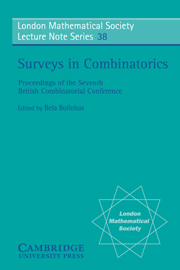Book contents
- Frontmatter
- Contents
- PREFACE
- 1 Resonance and reconstruction
- 2 Symmetry conditions in graphs
- 3 Extremal hypergraph problems
- 4 Connectivity and edge-connectivity in finite graphs
- 5 Partition theory and its applications
- 6 Strongly regular graphs
- 7 Geometries in finite projective and affine spaces
- 8 Long cycles in digraphs with constraints on the degrees
- 9 Colouring problems and matroids
- Index
6 - Strongly regular graphs
Published online by Cambridge University Press: 17 March 2010
- Frontmatter
- Contents
- PREFACE
- 1 Resonance and reconstruction
- 2 Symmetry conditions in graphs
- 3 Extremal hypergraph problems
- 4 Connectivity and edge-connectivity in finite graphs
- 5 Partition theory and its applications
- 6 Strongly regular graphs
- 7 Geometries in finite projective and affine spaces
- 8 Long cycles in digraphs with constraints on the degrees
- 9 Colouring problems and matroids
- Index
Summary
INTRODUCTION
The present paper is meant to give a selfcontained introduction to the theory (rather than to the construction) of strongly regular graphs, with an emphasis on the configurational aspects and the Krein parameters.
The definition in graph-theoretical terms in §2 is translated into the language of matrices and eigenvalues in §3, leading to a short arithmetic of the parameters in §4. In §5 the adjacency algebra relates the combinatorial and the algebraic idempotents, leading to spherical 2-distance sets and the Krein inequalities. The absolute bound of §6 provides inequalities of a different type. Necessary and sufficient conditions for equality in either bound are considered in §7, as well as their graph-theoretic significance. Finally, the notion of switching is explained in §8, and illustrated by two explicit examples in §9.
Strongly regular graphs have been introduced by Bose [1], related to algebra by Bose and Mesner [2], to eigenvalues by Hoffman [11], and to permutation groups by D.G. Higman [10]. Scott [17] introduced the Krein parameters. Margaret Smith [20] considered extremal rank 3 graphs, providing a motivation for the recent work by Cameron et al. [7], whose pattern was followed in the present paper. For a survey of construction methods for strongly regular graphs the reader is referred to Hubaut [12], and for relations with other combinatorial objects to Cameron – van Lint [5], Cameron [6] and Goethals-Seidel [8],[9].
DEFINITIONS
We shall deal with ordinary graphs (undirected, without loops and multiple edges) having a finite number n of vertices. For any pair of vertices a between-vertex is a vertex adjacent to both.
- Type
- Chapter
- Information
- Surveys in Combinatorics , pp. 157 - 180Publisher: Cambridge University PressPrint publication year: 1979
- 21
- Cited by



